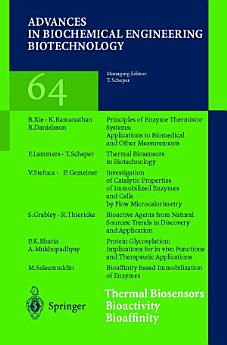Thermal Biosensors Bioactivity Bioaffinity
Thomas Scheper
জুন ২০০৩ · Advances in Biochemical Engineering/Biotechnology কিতাপ 64 · Springer
ইবুক
239
পৃষ্ঠা
reportমূল্যাংকন আৰু পৰ্যালোচনা সত্যাপন কৰা হোৱা নাই অধিক জানক
এই ইবুকখনৰ বিষয়ে
The immobilized biocatalyst (IMB) is a key component of biotransformation systems that are used to transform substrates to desired products. The impro- ment of biocatalyst properties has a direct influence on the overall effectiveness of the process based on the biotransformation. The basic catalytic characte- stics of biocatalyst that are followed include kinetic properties, pH optima, stability, and inhibition. The investigation of catalytic properties of immobilized enzymes is still a time consuming procedure and is not always simple. In the 1980s, a major effort was made to standardize the rules by which IMB is char- terized. The Working Party of EFB on immobilized biocatalysts has formul- ed principles of individual methods, among them the requirement of kinetic characterization [1]. It was recommended to use a packed-bed reactor, equipped with temperature control and with infinite flow circulation. The system should be equipped with a post-column unit to measure the time-dependence of the product or substrate concentration [2, 3], the most commonly used analytical methods being spectrophotometry, chemiluminiscence, automatic titration, bioluminiscence, chromatography, polarimetry, and biosensors based on the oxygen electrode. There are two main drawbacks to the application of these methods: 1. The need to vary the analytical principles, depending on the chemical and physical-chemical properties of analytes; 2. In some cases, mainly in the study of hydrolytic enzymes, the natural s- strate must be replaced by an artificial one, that is chromolytic, chromogenic, chemiluminiscent, bioluminiscent, or fluorescent.
এই ইবুকখনক মূল্যাংকন কৰক
আমাক আপোনাৰ মতামত জনাওক।
পঢ়াৰ নির্দেশাৱলী
স্মাৰ্টফ’ন আৰু টেবলেট
Android আৰু iPad/iPhoneৰ বাবে Google Play Books এপটো ইনষ্টল কৰক। ই স্বয়ংক্রিয়ভাৱে আপোনাৰ একাউণ্টৰ সৈতে ছিংক হয় আৰু আপুনি য'তে নাথাকক ত'তেই কোনো অডিঅ'বুক অনলাইন বা অফলাইনত শুনিবলৈ সুবিধা দিয়ে।
লেপটপ আৰু কম্পিউটাৰ
আপুনি কম্পিউটাৰৰ ৱেব ব্রাউজাৰ ব্যৱহাৰ কৰি Google Playত কিনা অডিঅ'বুকসমূহ শুনিব পাৰে।
ই-ৰীডাৰ আৰু অন্য ডিভাইচ
Kobo eReadersৰ দৰে ই-চিয়াঁহীৰ ডিভাইচসমূহত পঢ়িবলৈ, আপুনি এটা ফাইল ডাউনল’ড কৰি সেইটো আপোনাৰ ডিভাইচলৈ স্থানান্তৰণ কৰিব লাগিব। সমৰ্থিত ই-ৰিডাৰলৈ ফাইলটো কেনেকৈ স্থানান্তৰ কৰিব জানিবলৈ সহায় কেন্দ্ৰত থকা সবিশেষ নিৰ্দেশাৱলী চাওক।







